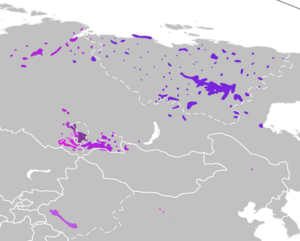The Siberian TurkicorNortheastern Common Turkic languages, are a sub-branch of the Turkic language family. The following table is based upon the classification scheme presented by Lars Johanson (1998).[1] All languages of the branch combined have approximately 750,000–1 million native and second language speakers, with most widely spoken members being Yakut (c. 500,000 speakers), Tuvan (c. 250,000 speakers) and Northern Altai (c. 57,000 speakers). Despite their usual English name, two major Turkic languages spoken in Siberia, Siberian Tatar and Southern Altai, are not classified as Siberian Turkic, but are rather part of the Kipchak subgroup.
| Siberian Turkic | |
|---|---|
| Northeastern Turkic | |
| Geographic distribution | Siberia |
| Linguistic classification | Turkic
|
Early form | |
| Subdivisions |
|
| Glottolog | nort2688 (North) sout2693 (South) west2402 (West Yugur) |
 Yakut Dolgan Khakas Chulym Shor Altai Tuvan Tofa W. Yugur Fuyu K. | |
| Proto-Turkic | Common Turkic | Northeastern Common Turkic (Siberian) | North Siberian | ||
| South Siberian | Sayan Turkic | ||||
| Yenisei Turkic |
| ||||
| Chulym Turkic |
| ||||
| Old Turkic | |||||
Alexander Vovin (2017) notes that Tofa and other Siberian Turkic languages, especially Sayan Turkic, have Yeniseian loanwords.[11]
{{cite book}}: CS1 maint: others (link)
This article about a Turkic language or related topic is a stub. You can help Wikipedia by expanding it. |